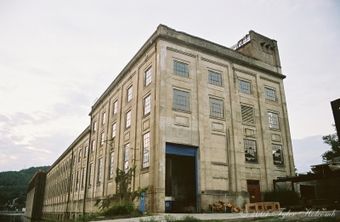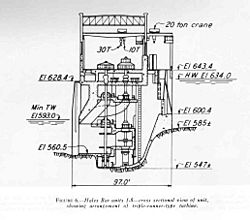Hales Bar Dam facts for kids
Quick facts for kids |
|
|
Hale's Bar Dam Powerhouse
|
|

Hales Bar Dam Powerhouse, now being used as a private event location. It is also open for reservation-only tours.
|
|
| Location | 1265 Hale's Bar Rd., Haletown, Tennessee |
|---|---|
| Area | 2 acres (0.81 ha) |
| Built | 1905-1913 |
| Architect | John Bogart |
| Architectural style | Classical Revival |
| NRHP reference No. | 08001111 |
| Added to NRHP | November 25, 2008 |
The Hales Bar Dam was a hydroelectric dam built on the Tennessee River in Marion County, Tennessee, United States. The Chattanooga and Tennessee River Power Company started building it on October 17, 1905. It was finished on November 11, 1913. This made Hales Bar one of the first big dams to be built across a river that ships could use in the United States. It began making electricity on November 13, 1913.
On August 15, 1939, the Tennessee Valley Authority (TVA) took control of Hales Bar Dam. The TVA was created by President Franklin D. Roosevelt to manage floods and produce hydropower in the Tennessee Valley. TVA bought the dam after a long legal process.
The TVA spent 20 years trying to fix a problem with the dam leaking. But the leaks continued. Also, making the dam's navigation lock bigger would have cost too much money. So, TVA decided to build a new dam instead. They built Nickajack Dam about 6 miles (9.7 km) downstream. Hales Bar Dam stopped working on December 14, 1967.
Contents
Where Was Hales Bar Dam Located?
Hales Bar Dam was located on the Tennessee River. It was about 431 miles (694 km) from where the river flows into another body of water. This spot was near the southwest end of the Tennessee River Gorge. The water held back by the dam formed a lake that stretched up the river to Chattanooga. This lake had about 162 miles (261 km) of shoreline.
Before Hales Bar Dam was built, this part of the river was very dangerous. It had strong currents and many obstacles that made it hard for boats to travel. Downstream from the dam, the river becomes calmer as it reaches the flatter lands near Guntersville.
How Big Was the Dam?
Hales Bar Dam was 113 feet (34 m) high and 2,315 feet (706 m) long. Its spillway, which lets extra water out, could release a lot of water. After TVA made improvements in 1949, the dam could produce 99,700 kilowatts of electricity. The dam also had a lock for boats, which opened on November 1, 1913. This lock was 60 feet (18 m) wide and 260 feet (79 m) long. Its 41-foot (12 m) lift was the highest in the world at that time.
Building the Hales Bar Dam
The Tennessee River Gorge was a big problem for boats traveling on the upper Tennessee River. Other parts of the river, like Muscle Shoals, also made it hard to navigate. In the 1800s, some canals were built to help, but the Tennessee River Gorge remained difficult to pass.
In 1898, business people from Chattanooga formed a group to push for year-round boat travel to Chattanooga. Around 1900, Major Dan C. Kingman of the U.S. Army Corps of Engineers designed a dam. This dam would flood the Tennessee River Gorge, making it safer for large boats. In 1904, Josephus Conn Guild offered to build the dam using private money. In return, his company would get the right to use the dam's power to make electricity.
Congress approved the plan on April 27, 1904. Guild, with money from Charles E. James and Anthony Brady, created the Chattanooga and Tennessee River Power Company. This company would manage the project. The dam was first expected to cost $3 million. But by the time it was finished, it cost $10 million.
Challenges During Construction
The first company hired, William J. Oliver and Company, started building the dam in October 1905. Two small towns, Guild (now Haletown) and Ladds, were built to house the thousands of workers. The dam was supposed to be finished by 1909. However, many problems caused delays. The main issue was the soft ground the dam was built on. By 1910, only the lock and powerhouse were done.
Engineers started to make progress by using new methods. They used pressure grouting and concrete caissons. These were new ways to build a major dam. Hales Bar Dam was finally finished on November 11, 1913.
But leaks started almost right after it was built. In 1919, engineers tried to stop the leaks by pumping hot asphalt into the dam's foundation. This worked for a while. However, by 1931, a study showed the dam was leaking a lot of water.
TVA Takes Over the Dam
The TVA Act was passed in 1933. This law created the Tennessee Valley Authority and gave it control over flood management and power projects in the Tennessee Valley. By this time, Chattanooga and Tennessee River Power had joined with other companies to form the Tennessee Electric Power Company (TEPCO).
TEPCO challenged the new TVA law in court. But in 1939, the U.S. Supreme Court decided that the TVA Act was legal. A few months later, TEPCO had to sell most of its property, including Hales Bar Dam, to TVA for $78 million.
After TVA took control in 1939, they did a lot of repair work on the dam's foundation. By 1943, they had stopped the leaks. In 1949, TVA made the dam's power production better. They also added new gates to the spillway. These gates helped extend the Hales Bar Reservoir's navigation channel.
However, in the late 1950s, new leaks appeared. An investigation showed the dam was leaking a lot of water again. Tests in 1960 suggested that many of the leaking paths were connected. This raised concerns about the dam possibly failing in the future.
Why Hales Bar Dam Was Replaced
In the 1960s, TVA began making its dam locks bigger. This was because more boats were using the rivers after World War II. A study in 1963 showed that making the Hales Bar lock bigger would be very expensive. Also, the dam kept needing expensive leak repairs. So, TVA decided to replace the dam completely.
Nickajack Dam was approved in January 1963. Its construction was finished on December 14, 1967. Hales Bar Dam stopped working the next day. By September 1968, Hales Bar Dam had been taken apart. This was done so it would not block boats on the new Nickajack Lake. Some of Hales Bar's generators and parts of its electrical equipment were moved and used at Nickajack Dam.
What Happened to the Dam Site?
The Hales Bar Dam Powerhouse was added to the National Register of Historic Places in 2008. Since the dam closed, the powerhouse has been used as a place for private events. You can also arrange tours by making a reservation. A marina for boats has also been built next to the site.





